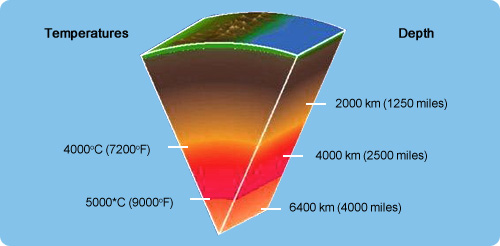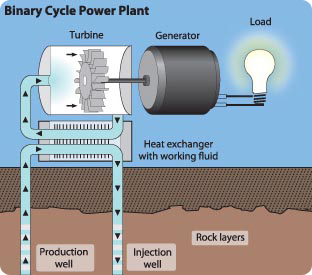ENERGY
Geothermal Energy
Geothermal energy comes from the heat within the Earth as the results of slow decay of radioactive particles, a process that happens in all rocks.
Temperatures in the Earth

The hot spring bathing is a typical application example of the geothermal energy since ancient times. Today, there have been direct uses of hot water heating buildings through district heating systems in which hot water near the Earth's surface can be piped directly into buildings and industries for heating.
Geothermal power plants are generally built where geothermal reservoirs are located within 3 to 4 km of the surface. They require high temperature (150 to 400 °C) from either dry steam wells or hot water wells to draw steam or hot water to the surface. Then the steam or hot water is diverted through a turbine engine which turns a generator.
Geothermal power plants

An alternative design is geothermal heat pump that uses stable ground or water temperatures near the Earth's surface to control building temperatures above ground. Geothermal heat pump transfers heat from the ground (or water) into buildings in winter and reverse the process in the summer for cooling. The US Environmental Protection Agency (EPA) presented that geothermal heat pumps are one of the most energy efficient, environmentally friendly, and cost effective systems for heating and cooling. Although most household heating or cooling still use traditional furnaces and air conditioners, geothermal heat pumps are becoming more popular in recent years.
The environmental impact of geothermal energy depends on how it is being used. Direct use and heating applications are believed to have less negative impact on the environment as they do not burn fuel to generate electricity, and their emission levels are very low. Some researches reveal that the geothermal energy system releases less than 1% of the carbon dioxide and 97% less acid rain-causing sulphur compounds than are emitted by fossil fuel plants.